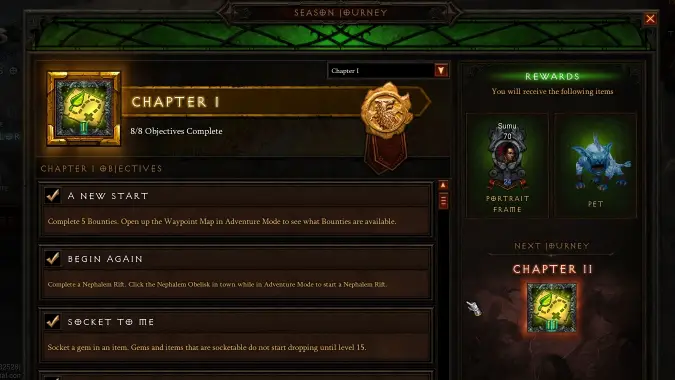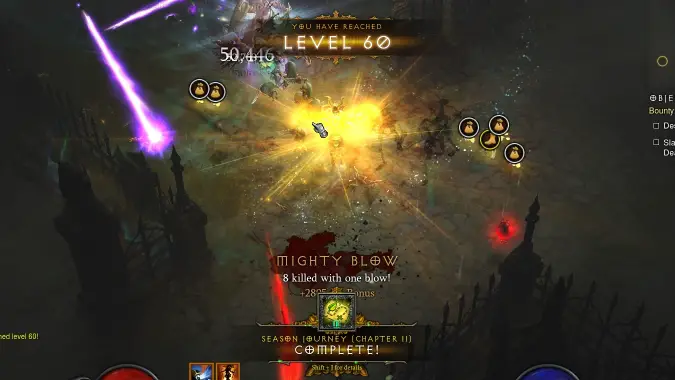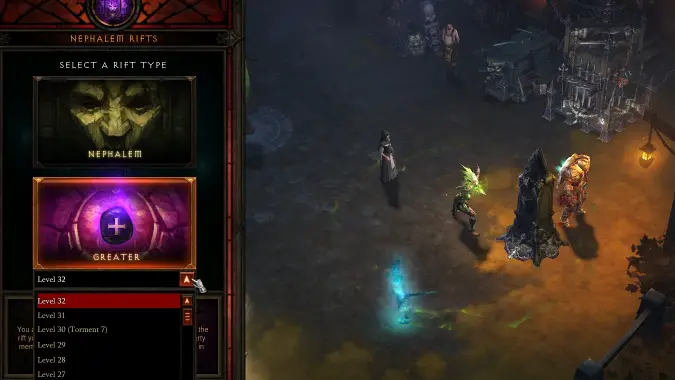Will seasonal objectives show off the core of Diablo 3?

My last run with the Diablo 3 patch 2.3.0 PTR was spent leveling a seasonal character so I could get a sneak peek at all the new seasonal objectives you have to complete to claim the pet and portrait rewards. It soon evolved into a mini-game of whether I could get the objective of a later chapter to go off before I got to see the list. I was able to guess some objectives from all three later chapters based on what I saw in Chapter I, but there was still some content that surprised me.
It’s obvious from the complete list that seasonal objectives are turning the point for playing a Diablo 3 Season into less of a leveling speed race and more of an “experience the core parts of the game” event. But do the seasonal objectives as we see them now currently represent the core parts of Diablo 3?
Introducing crafting
Over a third of the seasonal objectives deal with leveling or using your artisans to craft things. Crafting is a huge part of the game, though endgame deals primarily with enchanting through the Mystic. The flow of the crafting objectives mirrors what you probably would be doing anyway at that Chapter’s point in your leveling.
In Chapter I, you spend time leveling each of your three available artisans to level 5, then level 10 in Chapter II, then max level 12 in Chapter III. Chapter IV tops it off with using the first recipe in Kanai’s Cube to extract a legendary power from a legendary item. In Chapter II, you craft an item at the Blacksmith and transmogrify an item at the Mystic, which are common leveling things. Chapter III gets you to craft an Imperial gem as you reach higher levels and Chapter IV gets you into enchanting or rerolling a stat on an item at the Mystic as your gear starts to stabilize
You can, however, get later chapter objectives for crafting to go off very early on, and this makes the flow of these objectives feel wrongly paced. For example, you can go get Kanai’s Cube in Adventure Mode very early on in Chapter I — it just might take you forever to kill anything with your incredibly limited action bar. You also don’t end up using Kanai’s Cube until you’ve done bonus bounties several times, but you can save up materials for your first Cube use at 70 by leveling using bounties.

Encouraging difficulty progression
Each chapter has a “Kill an Act End Boss” kind of objective, and the only thing that changes is the difficulty and the second sentence that offers a loading screen-like tip. The bosses are the Act 1, 2, 3, 4, and 5 end bosses, respectively.
- Chapter I: Slay the Butcher, Belial, Azmodan, Diablo, or Malthael.
- Chapter II: Slay the Butcher, Belial, Azmodan, Diablo, or Malthael on Hard difficulty or higher. Higher difficulties also increase the amount of gold and experience you gain.
- Chapter III: Slay the Butcher, Belial, Azmodan, Diablo, or Malthael on Master difficulty or higher. On Master difficulty and higher, Imperial gems can drop from enemies level 61 and above.
- Chapter IV: Slay the Butcher, Belial, Azmodan, Diablo, or Malthael on Torment I difficulty or higher. Some legendaries and class sets can only drop in Torment I difficulty or higher.
You can get all four achievements by killing an Act end boss on Torment I the first time around, however difficult that might be solo with a brand new seasonal. But the difficulty progression is reasonable. The first step up is 1 difficulty level (Normal -> Hard), and then you go 2 levels (Hard -> Expert -> Master). Torment I is the entry-level Torment, so this introduces you to endgame as most players know it.
Leveling makes sense but holds back chapter progression
As a returning player of the game and older Seasons, the leveling objectives hold you back from progressing through other chapters. I often had 7/8 Seasonal objectives completed in the first few minutes of Chapters 1-3, and then was left grinding up to complete the level objective. Fortunately, I was able to knock out 1-70 solo in roughly 10 hours played, compared to my previous Seasons’ efforts of about 13.5 hours played for 1-70.
However, the leveling objective pace makes sense from a beginner player’s view, with or without the Reaper of Souls expansion. Progression through campaign on Normal generally leaves you in the mid-30’s level-wise when you finally beat Diablo, and reaching level 35 is the first leveling objective of Chapter I. (The Chapter I leveling objective is also oddly named the same as the level 40 achievement, despite being for level 35.) Level 60 is completed in Chapter II, and that’s obviously the vanilla Diablo 3’s maximum level. Level 70 is Reaper of Souls’ maximum level and can be completed in Chapter III.
I thought that Chapter IV might deal with Paragon points, as they are the “forever levels” that you find after you reach maximum level in Diablo 3. But I forgot how fast you go through the first twenty or so Paragon points, and the milestones of Paragon levels tend to be measured in 100’s, which takes quite a long time without a group. Instead, Chapter IV goes by a different, more important, and central leveling process: reach Greater Rift level 10. When you reach level 70 and can dive into Greater Rifts, you’ll find that the dropdown shows Greater Rift 10 as being approximate to Torment I — the same difficulty you have to defeat an Act end boss on in Chapter IV.

Bounties and Nephalem rifts
I think it’s a little odd that the “do a set of bounties” and “do a Nephalem Rift” objectives are the first ones you see in Chapter I. I can see bounties being introduced in Chapter I or II, because they are great sources of experience bar completion as well as crafting mats from the caches. I thought perhaps Chapter I would focus on completing campaign mode, though returning and veteran players would welcome the chance to do bounties over repeating the story mode for the umpteenth time.
The Nephalem Rift objectives — Chapter I’s run a Nephalem Rift and Chapter II’s run a Nephalem Rift on Hard — feel especially out of place, because the main point of running a regular Nephalem Rift in endgame over running a Greater Rift is to get Greater Rift keystones. But you can’t run a Greater Rift until you hit level 70 and the keystones don’t drop in the regular rifts until then, so it makes little sense to have an early leveling objective centered around Nephalem Rifts. Even the legendaries that drop in Nephalem Rifts while leveling soon get outpaced by other gear. I think the Nephalem rift objectives would be more welcome in Chapter III as you shoot for player level 70, in order to help prepare you to run a Greater Rift 10 in Chapter IV.
Keywardens
Chapter IV objectives speak a lot to what endgame is about: playing on a Torment level, enchanting items to reroll specific stats, using Kanai’s Cube, doing Greater Rifts, and eventually decking your character out in nothing but legendaries and class sets. But four out of the nine chapter objectives involve slaying a Keywarden.
I found this odd, because the Keywardens drop the items you need to open up the Uber boss events that you need to kill to get the legendary items to build the Hellfire Ring. The Hellfire Ring is a classic Diablo 3 complicated build-a-cool-thing, much like the old Staff of Herding was, and you should probably do it once for, well, for the Hell of it. But the Hellfire Ring is often more of a leveling gift to another toon rather than a coveted legendary for a powerful endgame build. The tip text on each kill objective just points to which Act and waypoint map has that particular Keywarden — it doesn’t explain why exactly you ought to go kill a Keywarden or where to go from there. The tooltip text on the Infernal Machine that drops from the Keywarden gives a hint, but it’s hard to know without reading an online guide about it that you need to go to the Heretic’s Abode in the back of Tristam in Act I to open the Uber portals, or that you need to buy the design for the Ring off Squirt in Act II to even do anything with the items you get from the Ubers themselves.
Although completing a full Hellfire Ring or even finding where the Uber portals are located is not required for completing the seasonal objectives, the Keywarden objectives feel odd to me. Killing Keywardens happens usually because I’m already out on the map doing a bounty, not because I’ve had a burning reason to grind them out for the Hellfire Ring. These four objectives feel separate from the obvious main focus of preparing to play endgame as we know it.
Please consider supporting our Patreon!
Join the Discussion
Blizzard Watch is a safe space for all readers. By leaving comments on this site you agree to follow our commenting and community guidelines.
 @_poneria
@_poneria



